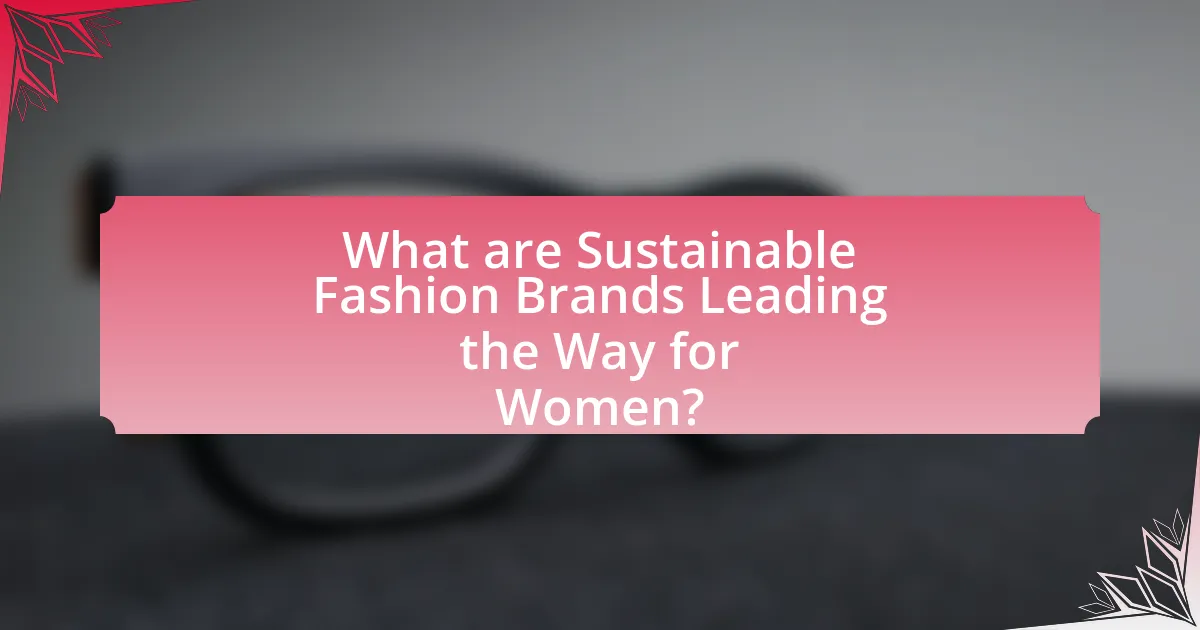Sustainable fashion brands such as Reformation, Eileen Fisher, and Stella McCartney are at the forefront of promoting ethical production and environmental responsibility for women. These brands prioritize eco-friendly materials, fair labor practices, and transparency in their supply chains, defining sustainability as a commitment to social equity and environmental stewardship. The article explores the materials these brands use, their unique practices, and the impact of sustainable fashion on women’s health, economic empowerment, and community engagement. Additionally, it addresses the challenges these brands face and highlights future trends in sustainable fashion, emphasizing the role of consumers in driving demand for ethical practices.

What are Sustainable Fashion Brands Leading the Way for Women?
Sustainable fashion brands leading the way for women include Reformation, Eileen Fisher, and Stella McCartney. Reformation focuses on eco-friendly materials and transparent supply chains, producing stylish clothing while minimizing environmental impact. Eileen Fisher emphasizes sustainable practices, including fair labor and organic fabrics, and has a take-back program for recycling garments. Stella McCartney is known for her commitment to cruelty-free fashion and innovative sustainable materials, setting industry standards for ethical practices. These brands exemplify leadership in sustainable fashion by prioritizing environmental responsibility and social equity.
How do these brands define sustainability in fashion?
Sustainable fashion brands define sustainability as a commitment to ethical production, environmental stewardship, and social responsibility. These brands prioritize the use of eco-friendly materials, such as organic cotton and recycled fabrics, to minimize environmental impact. They also implement fair labor practices, ensuring that workers are treated ethically and compensated fairly. For example, brands like Stella McCartney emphasize cruelty-free practices and transparency in their supply chains, showcasing their dedication to reducing carbon footprints and promoting circular fashion. This approach not only addresses environmental concerns but also fosters a more equitable industry, aligning with the growing consumer demand for responsible fashion choices.
What materials do sustainable fashion brands prioritize?
Sustainable fashion brands prioritize materials such as organic cotton, Tencel, hemp, recycled polyester, and linen. Organic cotton is favored for its reduced environmental impact compared to conventional cotton, as it is grown without synthetic pesticides or fertilizers. Tencel, made from sustainably sourced wood pulp, is known for its biodegradability and low water usage during production. Hemp is valued for its durability and minimal need for chemical treatments. Recycled polyester, derived from post-consumer plastic bottles, helps reduce waste and reliance on virgin materials. Linen, made from flax plants, is appreciated for its low water consumption and biodegradability. These materials collectively contribute to a more sustainable fashion industry by minimizing environmental harm and promoting resource efficiency.
How do these brands ensure ethical labor practices?
These brands ensure ethical labor practices by implementing strict codes of conduct for suppliers and conducting regular audits to verify compliance. For instance, many sustainable fashion brands require their suppliers to adhere to fair wage standards, safe working conditions, and the prohibition of child labor. Brands like Patagonia and Everlane publicly share their supply chain information, allowing consumers to trace the origins of their products and ensuring transparency. Additionally, certifications from organizations such as Fair Trade and the Global Organic Textile Standard (GOTS) provide third-party validation of ethical practices, reinforcing the brands’ commitment to labor rights.
Why is sustainable fashion important for women?
Sustainable fashion is important for women because it promotes ethical practices, reduces environmental impact, and empowers female consumers. The fashion industry is one of the largest polluters globally, with the production of clothing contributing to significant waste and carbon emissions. By choosing sustainable fashion, women support brands that prioritize eco-friendly materials and fair labor practices, which can lead to improved working conditions for female garment workers. Additionally, sustainable fashion encourages women to make informed purchasing decisions, fostering a sense of agency and responsibility towards the planet and society. This shift not only benefits the environment but also aligns with the growing demand for transparency and ethical standards in the fashion industry.
What impact does sustainable fashion have on women’s health and well-being?
Sustainable fashion positively impacts women’s health and well-being by promoting the use of non-toxic materials and ethical production practices. These practices reduce exposure to harmful chemicals often found in conventional textiles, which can lead to skin irritations and long-term health issues. For instance, a study published in the Journal of Environmental Health found that women who wear clothing made from organic cotton experience fewer allergic reactions compared to those wearing conventional cotton. Additionally, sustainable fashion encourages mental well-being by fostering a sense of community and empowerment among women who support ethical brands, as highlighted in research by the Fashion Institute of Technology, which indicates that consumer engagement in sustainable practices enhances self-esteem and social connections.
How does sustainable fashion empower women economically?
Sustainable fashion empowers women economically by providing them with fair wages, job opportunities, and skills development in ethical production environments. For instance, brands that prioritize sustainability often source materials from local communities and employ women in their supply chains, ensuring they receive equitable pay compared to traditional garment industry standards. According to a report by the World Bank, women in the textile sector can earn up to 30% more when working for companies that adhere to sustainable practices. This economic empowerment not only enhances their financial independence but also fosters community development and supports the overall economy.
What are some examples of leading sustainable fashion brands for women?
Some examples of leading sustainable fashion brands for women include Reformation, Stella McCartney, and Eileen Fisher. Reformation is known for its eco-friendly practices and transparency in sourcing materials, with a commitment to reducing carbon emissions and water usage. Stella McCartney has been a pioneer in sustainable luxury fashion, utilizing innovative materials like organic cotton and recycled polyester while advocating for animal rights. Eileen Fisher focuses on ethical production and sustainable materials, with initiatives aimed at reducing waste and promoting fair labor practices. These brands exemplify the integration of sustainability into women’s fashion.
What unique practices do these brands implement?
Sustainable fashion brands implement unique practices such as using eco-friendly materials, promoting ethical labor practices, and adopting circular fashion principles. For instance, brands like Reformation utilize sustainable fabrics like Tencel and recycled materials, significantly reducing their environmental impact. Additionally, companies such as Eileen Fisher focus on fair labor practices, ensuring that workers receive fair wages and safe working conditions. Furthermore, brands like Patagonia emphasize circular fashion by encouraging customers to repair and recycle their clothing, thus minimizing waste and promoting sustainability. These practices collectively contribute to a more responsible and ethical fashion industry.
How do these brands engage with their communities?
Sustainable fashion brands engage with their communities through initiatives that promote environmental awareness, social responsibility, and inclusivity. For instance, many brands host workshops and events that educate consumers about sustainable practices, such as upcycling and ethical sourcing. Additionally, these brands often collaborate with local artisans and organizations, fostering economic empowerment and community development. A notable example is Patagonia, which has implemented programs like “Worn Wear,” encouraging customers to repair and recycle their clothing, thereby reducing waste and promoting a circular economy. This approach not only strengthens community ties but also aligns with the brands’ core values of sustainability and ethical fashion.
How can consumers identify sustainable fashion brands?
Consumers can identify sustainable fashion brands by looking for certifications, transparency in sourcing, and ethical production practices. Certifications such as Global Organic Textile Standard (GOTS) and Fair Trade indicate adherence to environmental and social standards. Additionally, brands that provide detailed information about their supply chain and materials used demonstrate a commitment to sustainability. Research shows that 66% of consumers are willing to pay more for sustainable brands, highlighting the growing demand for transparency and ethical practices in the fashion industry.
What challenges do sustainable fashion brands face?
Sustainable fashion brands face significant challenges, including high production costs, limited access to sustainable materials, and consumer awareness. High production costs arise from the need for ethical labor practices and eco-friendly materials, which can lead to higher retail prices compared to fast fashion alternatives. Limited access to sustainable materials is a challenge because the supply chain for these resources is often not as developed or scalable as conventional materials, making it difficult for brands to meet demand. Additionally, consumer awareness is a barrier; many consumers remain unaware of the environmental impact of their clothing choices, which affects their purchasing decisions. According to a 2021 survey by McKinsey & Company, only 30% of consumers are willing to pay more for sustainable products, highlighting the need for increased education and marketing efforts in the sustainable fashion sector.
How do these challenges affect their growth and visibility?
Challenges such as limited resources, market competition, and consumer awareness significantly hinder the growth and visibility of sustainable fashion brands. These brands often struggle to secure funding and scale operations, which restricts their ability to reach a wider audience. For instance, a report by McKinsey & Company indicates that sustainable brands face a 30% higher cost of production compared to conventional brands, making it difficult for them to compete on price. Additionally, consumer awareness about sustainability remains low, with only 27% of consumers actively seeking sustainable options, as highlighted in a survey by Nielsen. This lack of awareness limits the visibility of these brands in a crowded market, ultimately affecting their growth potential.
What are the future trends in sustainable fashion for women?
Future trends in sustainable fashion for women include the rise of circular fashion, increased use of eco-friendly materials, and a focus on transparency in supply chains. Circular fashion emphasizes the lifecycle of garments, promoting recycling and upcycling to reduce waste. The use of eco-friendly materials, such as organic cotton, Tencel, and recycled polyester, is expected to grow as brands seek to minimize their environmental impact. Additionally, consumers are increasingly demanding transparency, leading brands to disclose sourcing practices and labor conditions, which fosters trust and accountability. According to a report by McKinsey & Company, the sustainable fashion market is projected to grow significantly, reflecting a shift in consumer preferences towards ethical and sustainable practices.
How are technology and innovation shaping sustainable fashion?
Technology and innovation are transforming sustainable fashion by enabling more efficient production processes, reducing waste, and promoting eco-friendly materials. For instance, advancements in textile recycling technologies allow brands to repurpose old garments into new fabrics, significantly decreasing landfill contributions. Additionally, innovations like 3D printing and digital design reduce the need for physical samples, minimizing material waste. According to a report by McKinsey & Company, the adoption of digital technologies in fashion can lead to a 30% reduction in resource consumption. Furthermore, blockchain technology enhances transparency in supply chains, allowing consumers to verify the sustainability of their purchases. These technological advancements collectively contribute to a more sustainable fashion industry.
What role do consumers play in the evolution of sustainable fashion?
Consumers play a crucial role in the evolution of sustainable fashion by driving demand for eco-friendly products and influencing brands to adopt sustainable practices. Their purchasing choices increasingly favor brands that prioritize ethical sourcing, reduced waste, and transparency in production processes. For instance, a 2021 survey by McKinsey & Company found that 67% of consumers consider sustainability when making a purchase, indicating a significant shift towards environmentally conscious buying behavior. This consumer pressure encourages fashion brands to innovate and implement sustainable practices, thereby shaping the industry’s overall direction towards sustainability.
What practical tips can women follow to support sustainable fashion brands?
Women can support sustainable fashion brands by prioritizing purchases from companies that emphasize ethical production practices and environmentally friendly materials. This includes researching brands that are transparent about their supply chains and use organic or recycled materials, as studies show that sustainable practices can significantly reduce environmental impact. Additionally, women can choose to buy less frequently, opting for high-quality, timeless pieces that last longer, which aligns with the principles of sustainable fashion. Engaging in second-hand shopping or clothing swaps also contributes to sustainability by extending the life cycle of garments. By advocating for and sharing information about sustainable brands on social media, women can raise awareness and encourage others to make eco-conscious choices, further supporting the movement towards sustainable fashion.














